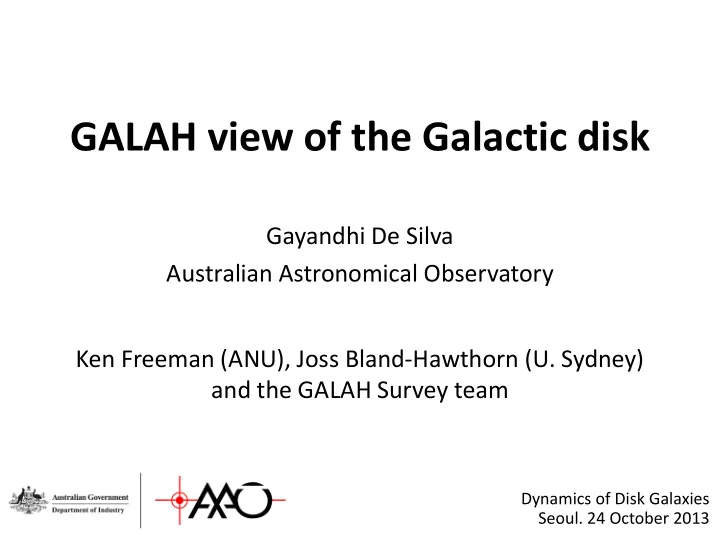

GALAH view of the Galactic disk Gayandhi De Silva Australian Astronomical Observatory Ken Freeman (ANU), Joss Bland-Hawthorn (U. Sydney) and the GALAH Survey team Dynamics of Disk Galaxies Seoul. 24 October 2013
What’s a Galah?
Target: a million stellar spectra at high resolution! 2/13
HERMES is a High Efficiency and Resolution Multi- Element Spectrograph on the 4m Anglo-Australian Telescope SNR = 100 @ V = 14 in 1hr • R ~28,000 or ~45,000 • 4 channels cover maximum • ‘good’ chemical element lines Uses 2dF fiber positioner to get • 392 stars over 2degree field Chann nnel el Wavel veleng ngth ( (Å) Blue 4708 - 4893 Green 5649 - 5873 Red 6481 - 6739 IR 7590 - 7890 3/13
Su Surve vey G Goals The major goal of GALAH is to identify chemically similar groups of stars in the Galactic disk, which are most likely ancient disrupted clusters, to decipher the star formation, migration and minor-merger history of the Milky Way. Key GALAH science questions: (a) When and where were the major episodes of star formation in the disk and what drove them? (b) To what extent is the Galactic disk composed of stars from merger events? (c) How have the stars that formed in situ in the disk evolved dynamically since their birth? (d) Where are the solar siblings that formed together with our Sun? 4/13
Tar arget S Sel elect ectio ion Simple selection criteria: 2MASS positions, APASS photometry, PPMXL proper motions • Galactic latitudes between ±10° and ±45° up to declination +10 • All targets from 12 < V < 14 • no colour selection • Expected contribution from Galactic components: − Thin disk ~ 75% − Thick disk ~ 24% − Bulge ~ 1% − Halo ~ 0.1% With HERMES ~ 350 stars per hour gives > 2000 stars per night At 100 nights per year for ~5 years gives > 1 million stars 5/13
Dat ata A a Anal nalysis is Data reduction pipeline “ 2dfrdr” developed at the AAO handles all their fibre based instruments and runs real time between exposures Automated abundance analysis pipeline “Theremin” developed within the GALAH collaboration (based on MOOG) provides: Stellar parameters: effective temperature, gravity, rotation • Radial velocities, variability, multiplicity flags, oddities • Abundances of individual elements: Li, C, O, Na, Al, K, Mg, Si, • Ca, Ti, Sc, V, Cr, Mn, Fe, Co, Ni, Cu, Zn, Y, Zr, Ba, La, Nd, Ce, Eu 6/13
Chem emic ical al Tagging ng Use the chemical information within stars to “t “tag” ” them to common formation sites (Freeman & Bland-Hawthorn 2002) Assumes stars form in clusters and such clusters are chemically homogenous – holds for present day open clusters. Method verified by identification of moving groups and stellar streams. Chemistry can differentiate origins of kinematical disk substructure, for example: • HR HR 1614 1614, Ar , Argus As Association & & Wolf 360 g 360 group = homogenous clusters De Silva et al. 2007, De Silva et al. 2013, Bubar & King 2010 • Her ercules = dynamical stream Bensby et al. 2007 • Hyade ades = both! 7/13 Pompeia et al 2011 De Silva et al 2011 Tabernero et al 2011
Hercules stream HR 1614 group Hyades stream 8/13
Blind chemical tagging of the Bensby et al. 2013 disk stars: Use group finding algorithm to tag 703 disk stars purely using chemical info Mitschang et al. 2013a, MNRAS # stars per group δ c (dex) 9/13
Chemical tagging could also provide ages for groups [Fe/H] [ α /Fe] Mitschang et al. 2013b, submitted 10/13
Recover such groups in a million stars to answer key questions: Chemo mo-dynamical ev l evolution: What are the dominant nucleosynthetic processes (principle chemical components) as a function of position, velocity and stellar orbital motions. Direct evidence for a physical sequence of disk evolution. Mi Mixing ng a and mi migration: n: what will be the distribution of stars in chemically recovered clusters - narrow range in R GC or spread over kpcs in radius? Will depend on migration and mixing efficiencies. Merger h er history ry: what will be the frequency of chemically tagged dwarf galaxy signatures vs. homogenous clusters. Will depend on the satellite galaxy infall rate. So Solar si sibli lings: s: chemically tag the solar family – chemical signature of planets, aliens? 11/13
Current S t Schedule ule HERMES commissioning: started, continue till Nov 2013 GALAH pilot survey: Nov 2013 – Jan 2014 GALAH main survey: 2014 – 2019 (?) 12/13
More details at: www.aao.gov.au/HERMES/GALAH/ The GALAH team on a horizontal branch 13/13
Recommend
More recommend